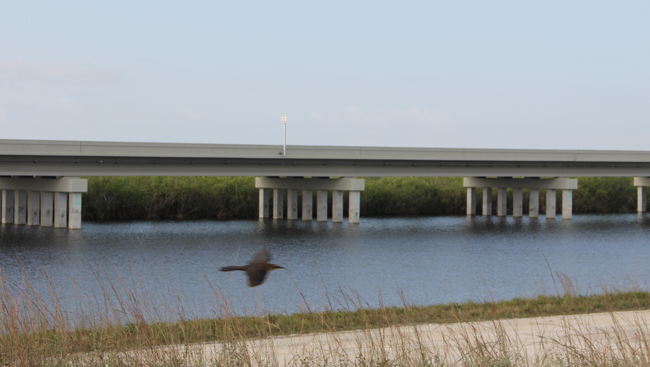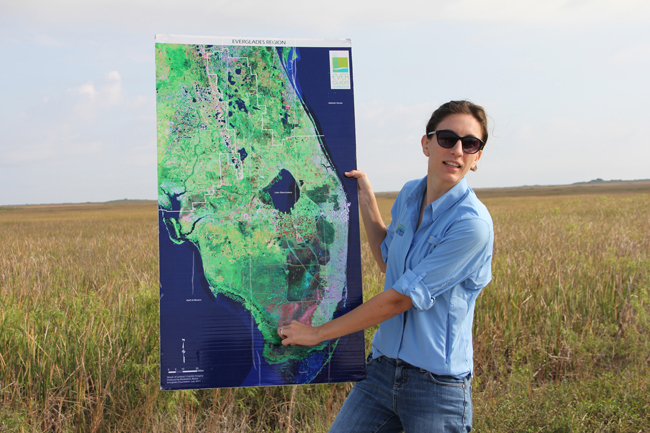Busting Barriers On Tamiami Trail
By Sylvia Cunningham
Over 86 years ago, the landscape of south Florida began to be transformed when thousands of workers assembled to tackle an immense project. Their objective: to take bulldoze hundreds of miles of mangrove trees and swamp and build a paved path from Tampa to Miami.
In 1928, five years after the project began, the 275-mile road had its grand opening. Travelers, who were now easily shuttled from one part of the state to the other via the “Tamiami Trail,” could thank engineers for the impressive feat. However, this was only the beginning of the roadway’s story.

Photo by Kaitlyn Carroll
Although the Tamiami Trail revolutionized the speed with which people traveled, there was a casualty in its creation. The highway sliced through the Everglades, disrupting the flow of water from Lake Okeechobee.
“What used to be continuous flow is now disconnected,” said Aida Arik, an ecological engineer for the Everglades Foundation. “The Everglades National Park is at the very end of the system and it doesn’t get the water that it needs.”
In March 2013, a ribbon cutting ceremony kick-started a new chapter in the highway’s life: a one-mile bridge, which cost $81 million, was built by the U.S. Army Corps of Engineers to alleviate some of the damage.
“It’s critical to uncork the system and send water south to the Everglades National Park,” Arik said. Even as scientists celebrated the first completed mile of bridging, they already had their sights set on the future.
The Everglades ecosystem thirsts for water, according to the National Parks Conservation Association, and the Everglades National Park receives only 30 percent of the water it needs.
Megan Tinsley, who worked with scientists at Audubon Florida for five years, said that although the park is not getting enough water, not everyone agrees how the problem should be fixed.
“Water is needed from a purely ecological standpoint, but the water is not the quality that the Everglades has historically received,” Tinsley said.
The Everglades is naturally a nutrient-limited system. However, due to poor farming practices south of Lake Okeechobee, Tinsley said, high levels of nitrogen and phosphorus have been pumped into the water.
The Miccosukee Tribe of Indians, according to Tinsley, fear the risk of creating additional problems if more water, with more phosphorus, is added to the Everglades especially south of the highway. The tribe rejects the notion that the Everglades National Park needs water at any and all costs.
“Scientists agree we are losing the historic sloughs. We’re losing what we think of as the Everglades,” Tinsley said. “But other people would say: you’re really losing the Everglades if you introduce water with higher phosphorus content.”
The Miccosukee Tribe has a reservation on the Tamiami Trail which the tribe’s website calls “the center of the Miccosukee Indian population” and operates everything from a health clinic to a police department to general stores. Tinsley said there is a longstanding mistrust between the Miccosukee Tribe and the government.
“It wasn’t very easy to work with them. They tend to operate as their own entity and do not want to cooperate with environmentalists. They put forward positions on behalf of the tribe without really working or discussing with any environmental groups. The relationship just wasn’t there,” Tinsley said. “I don’t know if it’s ever been there.”
Since the 1920s, the roadway has acted as a dam in which water could only pass through pipes. The system in place was ineffective and a cumbersome way of getting the resources the Everglades National Park needs, said Orlando Ramos-Gines, the senior project manager for the U.S. Army Corps of Engineers in the Okeechobee Section
“The idea is to maintain the water flow better, hydrate those areas and hopefully bring more wildlife to the area,” Ramos-Gines said.
Ramos-Gines joined the Tamiami Trail Project as the senior manager in October 2013 and is familiar with the frustrations that come along with funding a multimillion dollar project.
“Delays are mostly because of funding. You don’t get the funding, you don’t move forward,” he said.
Pieces of the $8 billion Everglades Restoration Project might have been implemented earlier, Ramos-Gines believes, if it were not for the Sept. 11 terrorist attacks in 2001.
“Because we got involved in wars, the money goes somewhere else,” said Ramos-Gines. “We have been able to continue, but at a slower place.”
Aside from monetary holdups, if the public is not educated to understand why exactly the Tamiami Trail needs to be adjusted, progress is also stalled.
John Volin, a professor in the Department of Natural Resources and the Environment at the University of Connecticut, has devoted most of his career to research in the Everglades. He said out of the six million people in the southeast corner of Florida, most have not been to the Everglades.

Photo by Kaitlyn Carroll
“Many don’t actually understand that that’s where their drinking water is coming from and the importance of the Everglades being there,” Volin said. “How are you going to get the community to sustain this type of effort? In the end, it comes through education.”
Habitats have already changed, and more are in danger. There’s evidence of it everywhere, Arik said.
“You can see it in the vegetation. What you see across the bridge is willow which tends to grow in dryer areas and it should be saw grass prairie,” Arik said.
There are unforeseen challenges, but Arik thinks that with cooperation and continued research, the Everglades Foundation and other organizations can team up to tackle what is to come.
“All these projects are new. They’re learning experiences,” Arik said. “But we do our best on the planning end of things to make sure we are taking our best step forward.”